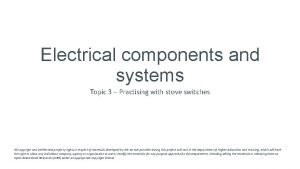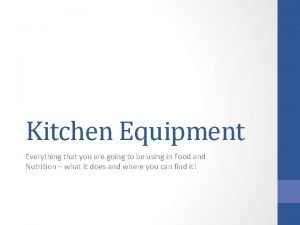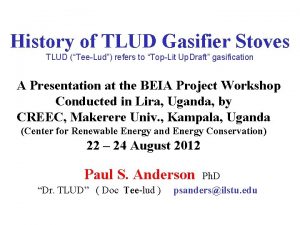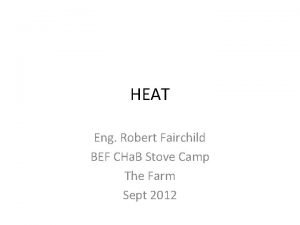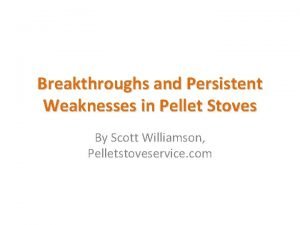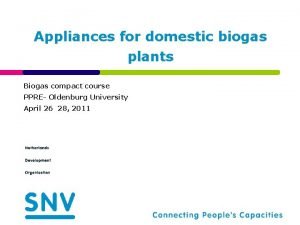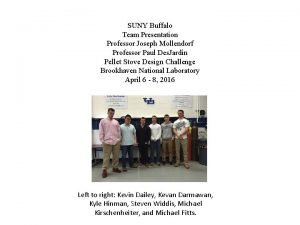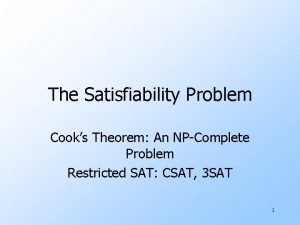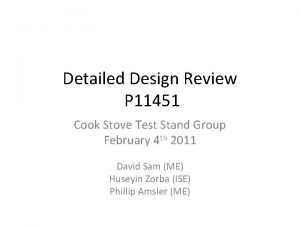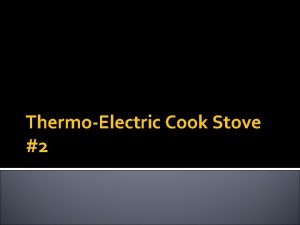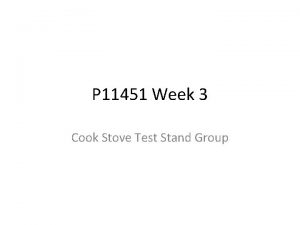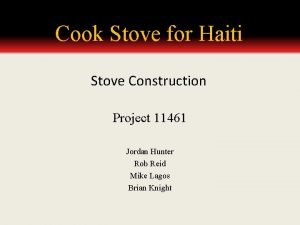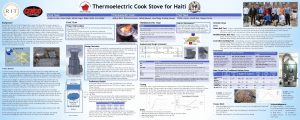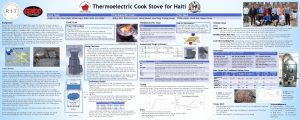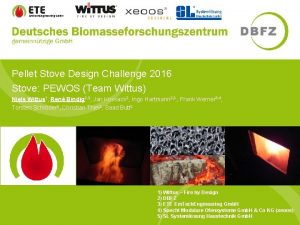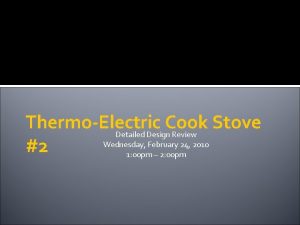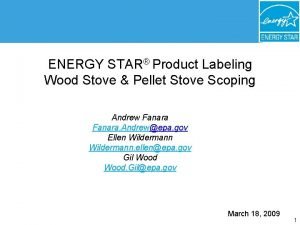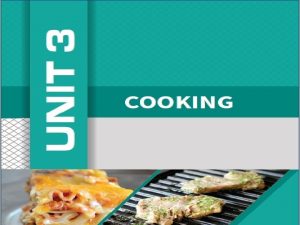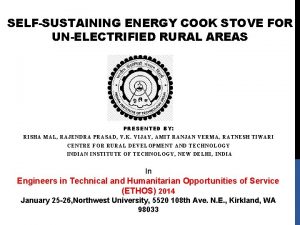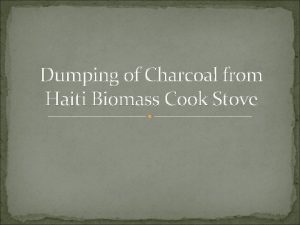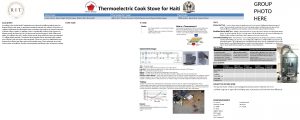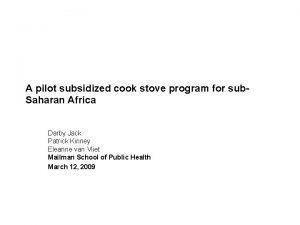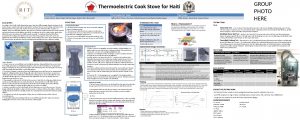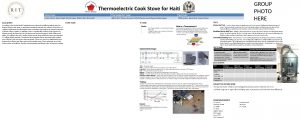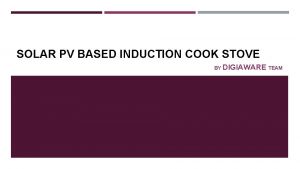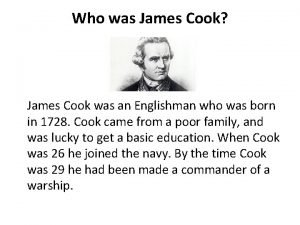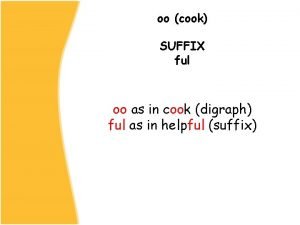P 11451 System Design Review Cook Stove Test
























- Slides: 24

P 11451 System Design Review Cook Stove Test Stand Group January 14 th 2011 David Sam (ME) Huseyin Zorba (ISE) Phillip Amsler (ME)

Agenda • • • • Project Description Customer Needs Engineering Specifications System Level Work Breakdown Fish Bone Diagram Schedule Risk List Test Stand Hardware Outputs Modifications to Test Stand Testing Extreme Conditions Error Testing and Benchmarking Particulate Measurement Concept Selection

Project Description • The mission of P 11451 is to define test methods and document testing procedures relevant to the Haitian customer needs • Deliverables: – Functioning test stand – Documented testing procedure – Documented benchmark results against published results – Produce results for project teams P 11461 and P 11462

Customer Needs Revision #: Customer Need # 3 Importance Description Comments/Status CN 1 1 Accurate Statistical Results: Repeatable results, minimize variability and quantify uncertainty Main customer need, by minimizing variability we can achieve repeatable results and quantify our uncertainty. CN 2 1 Document standardized water boil test Document a water boil test or modified water boil test with a test procedure and user manual. Document standardized quick stove test Create and document a quick stove test procedure for teams to test under a range of scenarios with instant feedback. By changing one input, user should be able to identify the impact in the output. This test should have a user manual. CN 3 1 CN 4 1 Document a field like test Create and document a test procedure to test the stove under Haitian cooking style which may include longer time to boil. Procedure should be documented with a user manual. CN 5 1 Measure efficiency and it's uncertainty Measure the efficiency of thermal versus chemical energy used. CN 6 1 Safety Test stand should be safe to operate for untrained users. CN 7 1 Benchmark against other stoves Test and compare our stove versus rebar stove or another kind of stove under same test conditions. This will allow comparison of results such as fuel usage, emissions, and time to boil CN 8 1 Quantify emissions Greenhouse gases such as CO. CN 9 2 Quantify particulate matter Any solid matter output from the stove into the surrounding environment. CN 10 2 Durable Test stand should be durable and able to withstand years of testing CN 11 2 Ease of use CN 12 2 Easily transportable Test stand should be ergonomic and easily used by one user. Also testing should be easily performed by any user. Test stand should be easily transportable by one user

Engineering Specifications Revision #: 3 Engr. Spec. Importance # ES 1 ES 2 ES 3 ES 4 ES 5 ES 6 ES 7 ES 8 ES 9 ES 10 1 1 1 Source CN 1, CN 2, CN 3, CN 4, CN 7 CN 1, CN 2, CN 3, CN 4, CN 5, CN 7 Specification (description) Unit of Measure Marginal Ideal Value Repeatable time to boil Standard <20% deviation (%) <10% Repeatable specific fuel consumption Standard <20% deviation (%) <10% Repeatable thermal efficiency of Coefficient of <20% stove Variation (%) <10% Standard <10% deviation (%) 1 Repeatable fuel rate CN 1, consumption CN 2, CN 3, CN 4 CN 7 Standard <10% deviation (%) <5% 1 CN 1, CN 2, Repeatable firepower CN 3, CN 4, CN 7 1 CN 1, CN 2, Accurate emission CN 3, CN 4, measurements CN 7, CN 8 Std Dev g (grams) <2. 0 grams < 1. 0 grams # Accidents 1 out of 0 30 tests <3 Number of accidents <5% Comments/Status Boiling time (mins) is an output of the WBT and customer need is to have these results be repeatable and to minimize variability Ratio of total amount of fuel (wood or charcoal) used to the amount of water (grams fuel/ grams of water) from WBT; this is a specification that can be used in benchmarking. Ratio of the work done by heating and evaporating water to the energy consumed by the fuel source. The thermal efficiency should be repeatable to ensure validity of testing. Fuel rate consumption (g/min), by obtaining repeatable results, we can observe the differences in setting up the fuel source and lighting procedure to help us determine the best method and which is conserve fuel the best. Fuel consumption is defined as the amount of fuel to produce a unit output. (How much fuel to boil water) Firepower (Watts) is the rate of fuel energy consumed by the stove per minute which can give us the power output of the stove in watts. This can be calculated from WBT data and could also be useful benchmarking. Based on Aprovecho WBT emission performance testing, cook stoves should emit less than 20 grams of CO and most forced air stoves emit less than 10 grams so we will look for a std dev less than 10%. (<2. 0 grams) Accidents relating to any burns, cuts, and shock should be zero for maximum safety during a standard WBT or any other test. This test stand must be safe for general use. 1 CN 6, CN 10 1 CN 2, CN 3, User manual ease CN 4, CN 8 # Questions 2 CN 1, CN 2, Accurate particulate CN 3, CN 4, measurements CN 7, CN 9 Based on Aprovecho WBT emission performance testing, cook stoves Std Dev (mg) <150 mg <50 mg should emit less than 1500 grams of particulate matter so we will be looking for a std dev less than 10% (<150 mg) 2 CN 11 CN 12 Set up time minutes <20 0 < 10 Through documentation, any user should be able to read and set up the test stand perform testing without any questions. Related to ease of use, set up time for any single user should not take longer than 20 minutes. Goal would be 10 minutes from transporting stand equipment to loading fuel and lighting fuel by one user.

System Level Work System Specifications (Size, Fan, etc. ) Noise Factors Outcomes Positives a)Efficiency Negatives a)Emissions b)Particulate Matter

System Level Work Inputs Test Standards a)Charcoal b)Stove (Any Kind) c)Test Type (Short, Relevant, WBT) d)Lighting Technique S Y S T E M Outputs a)Emissions b)Solid Wastes c)Test Time d)Efficiency e)Statistical Accuracy

System Level Work Goal Project Scope Inventory Quantify: Raw Material, Energy, Waste Perform the Test Impact Assessment Ecological Health Improvement Assessment Change in Design Waste Management

Work Break Down

Fish Bone

Schedule

Effect What is the effect on any or Short description of all of the project deliverables project risk. if the cause actually happens? Cause Importance # Risk Item Action to Minimize Risk Owner L*S What action(s) will you take (and by when) to prevent, reduce the impact of, or transfer the risk of this occurring? Who is responsible for following through on mitigation? 1 3 Minimize number of pieces in assembly, and increase mobility of stand. Huseyin 3 3 Careful handling of test equipment and solid repeatable procedure for good weather. Phil Dave Severity ID Likelihood Risk List What are the possible cause(s) of this risk? Time lost in experiment, and Test stand difficult to push, likely require more than 1 multiple pieces to assemble, 3 person to run difficult to hook up wires. 1 Test difficult to assemble or run. 2 Data acquisition hardware failure/breakdown Cost of new equipment, extra test needed. 3 Emission data inaccurate or immeasurable Emission data unknown, or could add noise to the system output. Emission sensor maxed out, not capable of reading highly concentrated 2 emissions, or placed in unrepresentative location. 2 4 Install researched and proven Emission measurement device, and test to ensure repeatability and accuracy. 4 Changing fuel type (hard/soft charcoal, wood, vines, and combinations) More variables, less repeatability, and more test runs needed. Changing, sizes, placement, 2 brands, or types of charcoal 2 4 Use one repeatable fuel type Dave 5 Ventilation Failure Emission data unknown, test will need to be redone. Fan won’t start, chimney breaks, or won’t attach properly. 2 4 Install dependable fan. Phil 6 Changing weather or Noise added to experimental atmospheric conditions efficiency, etc. Changing humidity, temperature, wind, etc. 7 Metrics could be inaccurate or changing. (Charcoal Mass, Water Volume, Environmental Effects) Bad test, data neglectedrepeatability decreases. Hotter fire from wood, general ware, or bad weather (rain). 1 2 3 2 6 Bad test standards, poor measurement devices, 3 procedure not followed properly, wind shaking scale. 3 9 Plan to standardize moisture in coal before the experiment, and generally plan for tests during fair weather. Solid repeatable procedure with proven measurement devices (i. e. beakers, scale, etc. ) Also, limiting testing days to “ideal” weather normalizing data to a certain temperature. Installed diffuser to minimize wind effect. Phil Huseyin

Test Stand Hardware Outputs Particulate Matter Solution CO Meter Choices EL-USBCO Problems CO Untested New Vent Fan Big Fan Temp Range Light Sensor UCB particulate monitor Price Filter Sample Relative Sample? Whole Chimney Impede Chimney? Uncertainties Testing Extreme Cases Wet/Dry Charcoal Wait time during lighting Δ Start Time Δ Emissions Charcoal sizes

Old Test Stand

Current Test Stand

Testing Extreme Conditions Test Wet/Dry Charcoal Varying Charcoal Sizes 1 Test with charcoal set at room humidity (~25%) Use charcoal straight from the bag (1 kg) 2 Test with charcoal set at high humidity (~75%) Cut coal into uniform pieces and place piece by piece in stove. (1 kg)

Error Testing and Benchmarking • Test a range of stoves to get an idea of variability from wind, humidity, stove size, temperature, and other variabilitys. • Test other stoves (i. e. . Rebar) for emissions – Compare to published WBT data – Check if test stand has systematic or arbitrary errors • If test is successfully repeatable then we will know how the P 11461 stove compares.

Particulate Filter Placement Pros QVent % Sampling Known Particulate Mass Negligible affect on flow rate Simple Test Method (mass difference) Cheap QLeak Minimum Change in Test Stand Cons QStove *Simple qualitative test with shirt or other impedance on Chimney will determine viability. Whole Chimney % Sampling Added Head Loss Unknown Relation Sample/Actual Could Choke Chimney Assumes Uniform Concentration Reverse QLeak Requires additional testing Batch Sampling Unknown Flow Rate Can be complex

The UCB Monitor

Particulate Measurement Concept Selection

Follow Up Topics • • Conceptual design approval Further Modifications UCB Monitor Purchase Expectations for remainder of quarter

Questions?

Supporting Slides 1

Supporting Slides 2
 Algebra 2 unit test
Algebra 2 unit test Stove switch wiring
Stove switch wiring The buzz saw snarled and rattled in the yard
The buzz saw snarled and rattled in the yard Stove uses and functions
Stove uses and functions Tlud gasifier
Tlud gasifier Lorena stove
Lorena stove Wood stove water heat exchanger
Wood stove water heat exchanger What happens when you put your hand on a hot stove
What happens when you put your hand on a hot stove Aladdin pellet stove
Aladdin pellet stove Biogas stove quotes
Biogas stove quotes Integrated stove workshop
Integrated stove workshop Buffalo pellet stove
Buffalo pellet stove Chapter review motion part a vocabulary review answer key
Chapter review motion part a vocabulary review answer key Ap gov final review
Ap gov final review Nader amin-salehi
Nader amin-salehi Systematic review definition
Systematic review definition Narrative review vs systematic review
Narrative review vs systematic review Input/output design
Input/output design User interface design in system analysis and design
User interface design in system analysis and design Dialogue design
Dialogue design Risk management cook county
Risk management cook county Staqc meaning nhs
Staqc meaning nhs The traveling public and tourism promoters
The traveling public and tourism promoters Cook's theorem
Cook's theorem Famous intrepreneurs
Famous intrepreneurs

